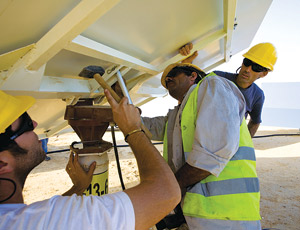Thanks in part to a controversial fast-track approval process, a major solar thermal power project is now under way in San Bernardino County.

The Ivanpah Electric Generating System, developed, owned and operated by BrightSource Energy Co., Oakland, and NGR Energy, Princeton, N.J., could deliver 370 MW per year of solar thermal power from the floor of the Mojave Desert as soon as 2013. Alternative-energy advocates praise the project as an example for accelerating regulatory approval for other solar power plants.
The 3,500-acre Ivanpah project, located along the California-Nevada border and adjacent to Interstate 15, is the first solar thermal plant constructed in California in 20 years.
At Ivanpah’s October groundbreaking, Ian Copeland, president of Bechtel Renewable Power, the project’s engineering, procurement and construction contractor, called it a model for future development of solar power plants. Bechtel also has an equity stake in the project.
A Sea Of Heliostat Mirrors
The project consists of three separate solar thermal powerplants powered by a sea of heliostat mirrors on dual-tracking axes, which focus sunlight to heat water in 450-foot-tall thermal boiler power towers.
The air-cooled system will convert water into steam in a closed-loop cycle that uses 100 acre-ft. of water per year, a 95% saving over wet-cooling.
BrightSource has contracts to sell a total of 2,600 MW of power to Pacific Gas and Electric and Southern California Edison.
Like most of the other six industrial-scale solar projects approved for the area, Ivanpah utilizes a tax credit—$1.37 billion in Ivanpah’s case—provided by the American Recovery and Reinvestment Act.
Ivanpah also benefited from a fast-track process, which allowed its projects to navigate approval processes from five government agencies—including the U.S. Fish and Wildlife Service, the Bureau of Land Management and the California Energy Commission (CEC)—at once.
The California Desert District Bureau of Land Management, Moreno Valley, leases the land to BrightSource and other industrial-scale solar projects.
Greg Miller, supervisory projects manager for the bureau’s renewable energy coordinating office, says the idea of working with other agencies to coordinate approvals has been happening informally for years, but was planned formally in 2009 when it became apparent that the projects would not meet tight federal stimulus-act deadlines without help.
Miller also saw the program as an enhancement for environmental reasons. “It allowed us to look at the projects on a landscape scale rather than case-by-case,” he says, adding that the benefit for the solar development companies was consistency.
“It was clear that if approvals had proceeded under business as usual, they would not have made the cutoff,” says Travis Coleman, project manager, renewable generation group, for the Electric Power Research Institute, Palo Alto, an independent energy-research organization.
Last year, the CEC approved a total of 4,000 MW of industrial-scale solar, including solar thermal and photovoltaic. According to Coleman, solar thermal had more to gain from the fast-track approach than photovoltaic projects would. The reason: solar thermal projects need large amounts of space and thus have few siting options other than on federal land.
By comparison, photovoltaic installations can be profitable on smaller footprints, Coleman says.
The upside for solar thermal and the utilities that integrate it into the grid is that the hot liquid takes longer to heat up, move through the system and cool. So when a cloud moves across the sun, the system acts less like an on/off compared to a photovoltaic, which stops working in that situation. Utilities thus are able to integrate the solar thermal resource into the grid more easily.
But critics have challenged large-scale solar operations planned to be located on federal property in the middle of the desert.
Environmental Groups Sue
In January, the Western Watersheds Project, an environmental group based in Clayton, Idaho, filed a lawsuit alleging that the Ivanpah project violated the Endangered Species Act because of the impact to desert tortoise habitat.
Article toolbar
Post a comment to this article
Report Abusive Comment